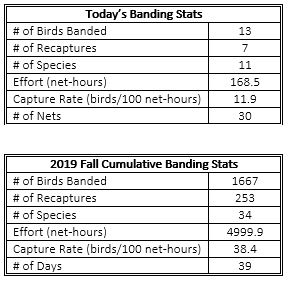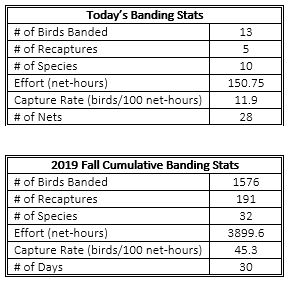Wednesday, September 18 & Thursday, September 19
Banding operations were canceled both Wednesday and Thursday due to weather; the combination of both cooler temperatures and rainy weather creates unsafe conditions for mist netting. We're hoping the forecast improves so that we can resume operations for the rest of the season.
 |
| Example of daily station stats from 9/17/19 |
We've had a couple questions about the daily station "statistics", so I thought I'd take a crack at decoding all the numbers I've been sharing with you this year. A rainy day seems like a perfect day to do it! Grab a cuppa of tea or coffee, and perhaps even a cookie or two.
# of Birds Banded
This is the number (quantity) of birds that had not been previously banded that we placed bands on. Sometimes you'll hear us call a bird a "new bird" or "unbanded".
# of Recaptures
This is the number (quantity) of birds captured that already have bands. This means that they have been banded previously at our station or another station. This does not include birds that are caught multiple times in a day (for example, if we were to release a bird and it were to fly directly into a net, we would release the bird without collecting any further information. If we were to catch that bird the next day, we would collect complete information on that bird). Thus it is important to note, that the total number of recaptures for the entire season
may not be "unique" birds (for example, think about how we catch the same BCCH multiple times in a season); in contrast, the number of recaptures in a single day
are unique birds.
# of Species
This is the number of different species that are represented in our captures for the day and year. You'll hear us talking about "first-of-seasons" (with lots of excitement) because it's the first time we've encountered that bird during the current season.
Number of Days
The is the number of days the station has operated. Days when banding is canceled (for example, the snow storms this spring or the rain this August) and nets aren't operated don't contribute to our capture effort.
Number of Nets
This seems simple, but it's a bit of a curve ball. This is the number of 12 meter mist nets opened during a banding day. Our canopy nets (nets 25, 19, 5, and 3) have multiple mist nets "stacked" on top of each other. Similarly, nets 29 and 7 are 6 meters in length and count as "half" a mist net. So, if we opened nets 1, 2, 3 and 7, we will have opened 4.5 nets (think: 1 + 1 + 2 + 0.5 = 4.5)
Effort (Net-hours)
Effort (or net-hours) refers to the amount of time a particular mist net has been active and able to capture a bird. Understanding how much "effort" (think: time opening a certain number of nets or a particular net) helps with future data analysis. This statistic reports the cumulative number of hours all nets opened have been operated in a day or full season. For example, if we open nets 1, 2, 3 and 7 from 8am to noon, each net will have been open for four hours. From our previous example we know that the number of nets totals 4.5, and thus our effort for this day is 18 net hours (4.5 * 4 = 18).
Capture Rate
Capture rate is a metric that indicates how "busy" our station was for an entire day (or the season) while also accounting for the variability in effort. This metric standardizes the number of captures (recaptures and newly banded birds are combined) using effort (net-hours). It's important to do this because we open a variable number of nets for a variable amount of time each day we operate. In other words, we want to know the number of birds we're catching given a certain amount of effort (think: birds per net-hour). In order to to expand this to include the cumulative effort of the station we further standardize this metric by 100 net-hours (so now think: # birds per 100 net-hours). Our station typically accumulates at least 100 net-hours per day of operation (remember that the greater number of nets we have open for longer increases the total number of net hours); other stations or analyses may use another quantity of net-hours to standardize their capture rate. We report the capture rate for the current day and for the entire season to get a "snapshot" of the entire season's effort (imagine if we captured our birds at a steady rate throughout the season instead of in "spurts"). Generally, a daily capture rate of 100 birds per 100 net-hours (or 1 bird per net-hour) is considered a busy day at most banding stations.
Going back to our example: if we capture 20 birds with nets 1, 2, 3, and 7 while they are open for 4.5 hours, then our capture rate is 111.1 ( (20 birds/18 net-hours) * 100 = 111.1). Thus we would expect that if those nets had accumulated 100 net-hours we would have captured 111 birds (we can't catch 0.1 birds!). Using this metrics we are better able to compare how "busy" the station across days than using the total number of birds captured.
Thinking further, total birds captured alone are misleading. For example, 75 birds one morning would appear to be more busy than a morning that captures 25, and the opposite is true if the 25 birds were banded in 20 net-hours (capture rate of 125) compared to 75 in 150 net-hours (capture rate of 50). So while 25 birds doesn't sounds like much, a capture rate of 125 is a busy morning regardless of the number of birds captured.
CFMS is a busy place for migrants but isn't as active as other stations in North American. Some potential reasons why are: the length of our banding season, our location in our fly-way, changes in habitat and disturbance at our station, and the variable size of our crew. Ultimately, our goals are to prioritize bird welfare and safety while collecting robust data in a standardized manner. Running fewer nets to accommodate the availability of skilled crew accomplishes this.


















































